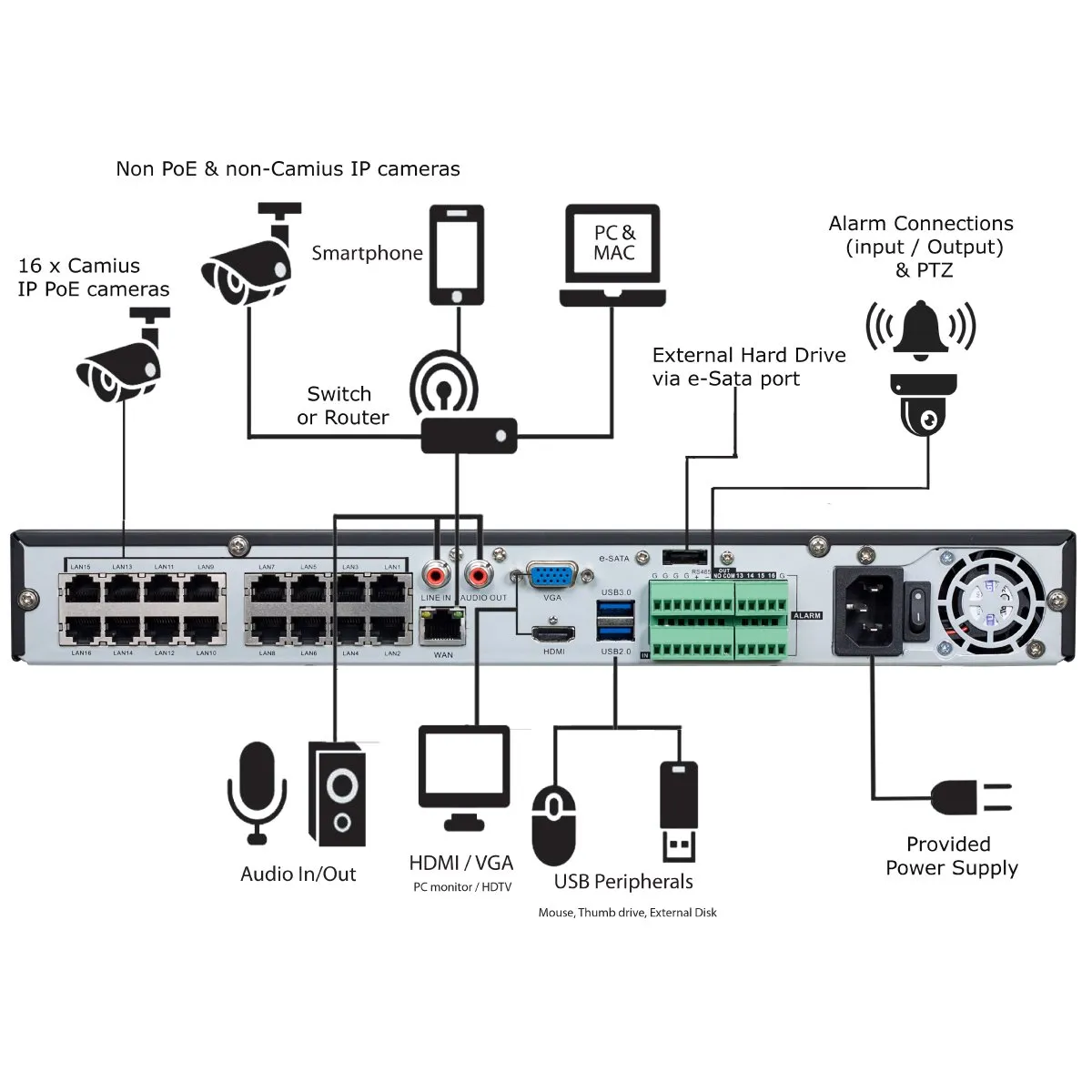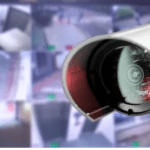What type of video connector do security cameras & DVR/NVR use?
- BNC Connectors for Analog & HD Analog Cameras.
- RJ-45 Connectors for IP Camera.
What are WDR security cameras used for?
Will bright daylight damage an infrared camera’s LEDs?
- No. LEDs are designed for use in both low-light and lighted areas. Daylight will not damage them. The infrared LEDs stay off during the day & turn on at night in the dark.
The power terminals on some cameras are not labeled positive and negative.?
- Some cameras are dual voltage and reverse polarity which means you can use an AC or DC power supply and either terminal for your positive and negative power lead. Unless otherwise noted by (+) positive and (-) negative labels on the camera.
.
What type of monitor can be connected to a DVR /NVR?
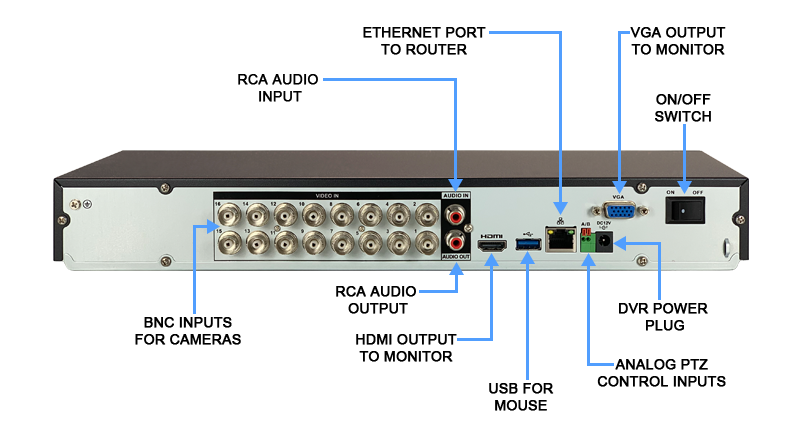
- In Short, this depends on NVR/DVR’s video output connections. Commonly These connections are available like BNC, VGA, and HDMI. A BNC video output can be connected to BNC inputs CCTV monitors. A VGA output can be connected to a standard VGA computer monitor & HDMI with HDMI Supported Display.
What does Pre / Post Alarm recording mean in DVR or NVR?

Pre and post-alarm recording are features found in many digital video recorders (DVRs) and network video recorders (NVRs).
Pre-alarm recording refers to the ability of a DVR or NVR to continuously record video footage for a certain amount of time before an event triggers an alarm. For example, if a security camera detects motion, the DVR/NVR will save the footage for a few seconds or even a few minutes before the motion was detected. This feature can be especially useful in situations where a quick response is required, such as in security or surveillance applications.
Post-alarm recording, on the other hand, refers to the ability of a DVR or NVR to continue recording video footage for a certain amount of time after an event has triggered an alarm. This allows you to see what happened after the event, which can help investigate the cause of the event or in identifying any suspects.
Both pre and post-alarm recordings can be customized to suit specific needs and scenarios. The amount of time recorded before and after an event can be adjusted, as can the trigger threshold for the alarm.
Pre and Post Alarm Recording allows the DVR/NVR to be configured to record before and after an alarm has been triggered. The recording Duration can be programmed as needed.
NVR does not recognize HDD
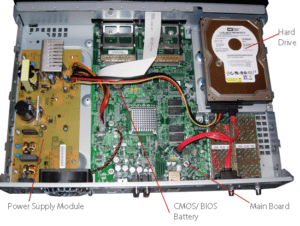
if your NVR is not recognizing your HDD, there are several possible reasons and solutions to consider:
Check if the HDD is properly connected: Ensure that the HDD is properly connected to the NVR and that the cables are secure. If it is an external HDD, ensure that the USB or eSATA cable is properly connected to the NVR.
Check if the HDD is compatible: Make sure that the HDD is compatible with your NVR & supported size. Check the NVR’s documentation to see which types of HDDs are supported. Some NVRs only support certain brands or models of HDDs.
Check for HDD errors: Check the HDD for errors or bad sectors. You can use a tool like Crystal Disk Info to check the HDD’s health status. You may need to replace the HDD if there are errors or bad sectors.
Format the HDD: If the HDD is new or has never been used with the NVR before, it may need to be formatted. Check the NVR’s documentation for instructions on how to format the HDD.
Check the NVR settings: Make sure that the NVR is set up to recognize the HDD. Check the NVR’s settings to ensure that it is configured to use the HDD as a storage device.
Update the NVR firmware: If the NVR firmware is outdated, it may not recognize the HDD.
What is NTSC mean in CCTV?
What is PAL mean in CCTV?
What is Alarm Input & Output in DVR/NVR& How to use them?
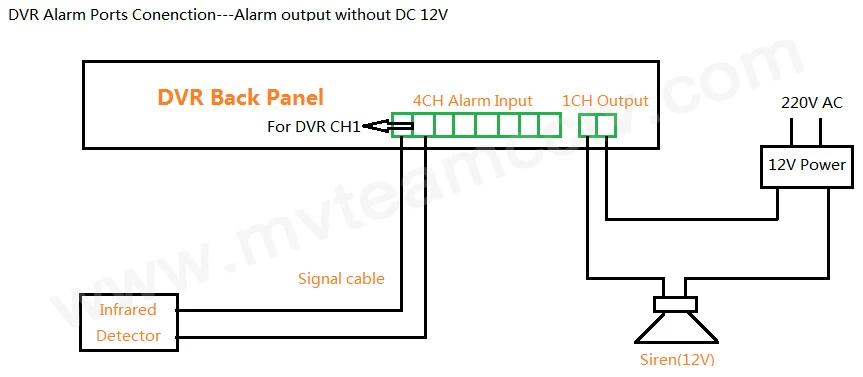
Alarm inputs and outputs are features commonly found in DVRs and NVRs that allow the user to connect external devices, such as sensors or alarms, to the system.
Alarm inputs refer to the ports on a DVR/NVR that are used to connect external devices that can trigger an alarm. These devices can include door sensors, motion detectors, glass break detectors, or any other device that is capable of sending a signal to the DVR/NVR. When an alarm input is triggered, the DVR/NVR can be programmed to perform a specific action, such as starting recording, sending an email alert, or triggering an alarm output.
Alarm outputs refer to the ports on a DVR/NVR that are used to connect external devices that can be triggered by the system. These devices can include sirens, lights, or any other device that is capable of being activated by an electrical signal. When an alarm output is triggered by the DVR/NVR, it sends a signal to the connected device, which then performs a specific action, such as sounding an alarm or illuminating a light.
Once you have connected the external devices to the appropriate ports, you can configure the system to respond to the signals sent by the devices. This usually involves setting up rules or triggers in the DVR/NVR software that define what actions should be taken when an alarm input is triggered. You can also configure the system to send notifications or alerts when an alarm input is triggered, such as an email or push notification to your phone.
HD-over-Coax Technology
HD-over-Coax cameras are surveillance cameras that use coaxial cables to transmit high-definition (HD) video signals. These cameras typically use the same coaxial cables that were traditionally used for analog CCTV cameras, but they can transmit much higher-quality video for a longer distance(upto1200m) due to advancements in camera technology. technology can simultaneously transmit 4 signals (audio, video, data, and power) over 1 coaxial cable.
There are several types of HD-over-Coax cameras:
AHD (Analog High Definition), HD-TVI (High-Definition Transport Video Interface),
HD-CVI (High-Definition Composite Video Interface).
Each of these technologies uses slightly different methods to transmit HD video over coaxial cables, but they all allow for much higher resolution and better image quality than analog CCTV cameras.
One of the main benefits of HD-over-Coax cameras is that they are often much easier to install than IP cameras, which require network infrastructure to transmit video signals. HD-over-Coax cameras can often be installed using the same cabling and equipment as analog CCTV cameras, which can save time and money on installation costs.
HD-over-Coax cameras are not as flexible as IP cameras, which can be used on a wide range of networks and can be easily integrated with other devices. HD-over-Coax cameras are typically limited to transmitting video signals over coaxial cables, which may not be ideal for all situations.
NVR/DVR often automatically shuts down or stops running or won’t boot.
NVRs and DVRs can sometimes experience issues where they shut down, stop running, or won’t boot. There are several potential causes.
Power supply issues: NVRs and DVRs require a stable power supply to function properly. If the power supply is insufficient or fluctuates, the device may shut down or fail to boot.
Overheating: NVRs and DVRs generate heat during operation, which can cause them to overheat
Hard drive failure: check the proper installation of HDD &HDD status; it may cause system failure.
Software issues: NVRs and DVRs rely on software to function properly. The wrong firmware upgrades may damage.
My IP Camera goes offline from time to time
If your IP camera is offline from time to time, there are several potential causes for this issue, including:
Network connectivity issues: IP cameras require a stable network connection to function properly.
Power supply issues: IP cameras require a stable power supply (PoE/Power Supply)to function properly.
Camera configuration issues: If the camera is not configured properly.
Firmware issues: If the camera’s firmware is outdated or corrupted,
Network IP conflict.
Check if the network environment is normal, and if there is disconnection or power failure during the upgrade.
Displays “Resources are limited, failed to open video” after I log in to the IP Camera
Insufficient bandwidth: IP cameras require sufficient network bandwidth to stream video.
Network congestion: If there are a lot of devices on your network or if there is network congestion, the camera may not be able to stream video and you may see this error message.
Too many users logging in, and it is beyond the device code stream output capacity.
Reset your browser or your IPC too

